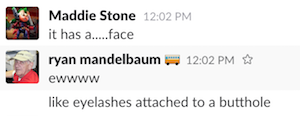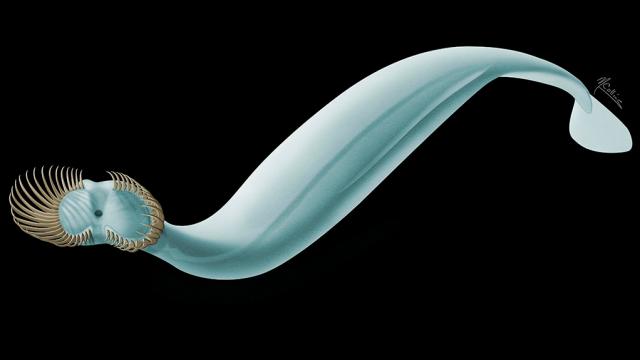Earth’s ancient oceans were rife with nightmare creatures, from many-limbed worms to 2m-long crab-ancestors. This week, scientists are taking the prehistoric freak show to another level, with a new paper introducing Capinatator praetermissus, the 500-million year old bristled-jawed worm monster pictured above.
Illustration by Marianne Collins. Copyright Royal Ontario Museum.
You know what it looks like. We know what it looks like. It looks like an anus-eye.

Chaetognaths, also known as arrow worms, are a diverse phyla of tiny predators that swim about eating smaller zooplankton in the open ocean. They evolved hundreds of millions of years ago, possibly during the early Cambrian, but where exactly they fit among other animals on the evolutionary tree isn’t totally clear. As one of the most striking chaetognaths ever discovered, Capinatator praetermissus could shed light on how these critters, their lifestyle, and their ecological roles have evolved over time.
Also, as a reminder, this one looks like an anus-eye.
As detailed in this week’s Current Biology, researchers at the Yale Peabody Museum of Natural History and the Royal Ontario Museum drew on roughly 50 fossils specimens, collected from the Burgess Shale fossil bed in British Columbia, in order to identify Capinatator praetermissus as a new genus and species of arrow worm. Fossilised chaetognaths that include evidence of soft tissue are incredibly rare — the researchers say only two other unequivocal specimens have been reported, and both from fossil beds in China. Many of the specimens in the new paper feature evidence of soft tissue, which allowed scientists to piece together the anatomy of the animal’s gut and musculature.

A tortured soul cries out from beyond the grave. Image: J.B. Caron/Royal Ontario Museum
According to the researchers, the animal’s head configuration is “unique”, with roughly 25 grasping spines per side. It probably captured its prey by flapping its graspy bits toward one another, forcing its helpless victims into its anus-shaped mouth. Capinatator may have only been four inches long, but it still would have been a “terrifying sight” to small marine critters alive at the time, according to study co-author Jean-Bernard Caron.
“The large body size and high number of grasping spines in C. praetermissus may indicate that miniaturization and migration to a planktonic lifestyle,” the lifestyle most chaetognaths enjoy today, “were secondary,” the researchers write. Earlier forms like this one might have prowled closer to the seafloor, and been larger than their contemporaries. Obviously, more fossil specimens from the same time period could help confirm or refute that idea.
But more importantly — dang, look at that anus-eye.
